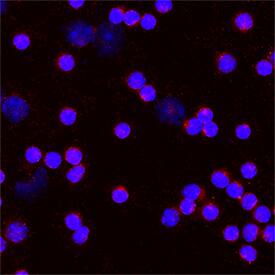Mouse B7-H2 Antibody
R&D Systems, part of Bio-Techne | Catalog # AF158


Key Product Details
Species Reactivity
Applications
Validated:
Cited:
Label
Antibody Source
Product Specifications
Specificity
Clonality
Host
Isotype
Scientific Data Images for Mouse B7-H2 Antibody
B7-H2 in Mouse Splenocytes.
B7-H2 was detected in immersion fixed mouse splenocytes using Goat Anti-Mouse B7-H2 Antigen Affinity-purified Polyclonal Antibody (Catalog # AF158) at 15 µg/mL for 3 hours at room temperature. Cells were stained using the NorthernLights™ 557-conjugated Anti-Goat IgG Secondary Antibody (red; NL001) and counterstained with DAPI (blue). Specific staining was localized to cytoplasm. Staining was performed using our protocol for Fluorescent ICC Staining of Non-adherent Cells.Applications for Mouse B7-H2 Antibody
Immunocytochemistry
Sample: Immersion fixed mouse splenocytes
Western Blot
Sample: Recombinant Mouse B7-H2 Fc Chimera (Catalog # 158-B7)
Formulation, Preparation, and Storage
Purification
Reconstitution
Formulation
Shipping
Stability & Storage
Background: B7-H2
Mouse B7-H2, also called B7RP-1, B7h, LICOS, and GL50, is a member of the growing B7 family of immune costimulatory proteins. Other family members include B7-1, B7-2, B7-H1 (PD-L1), PD-L2, and B7-H3. B7 proteins are members of the immunoglobulin (Ig) superfamily. The extracellular domains contain 2 Ig-like domains and all members have short cytoplasmic domains. Among the family members, they share about 20‑25% amino acid identity. Mouse and human B7-H2 share approximately 49% amino acid identity. B7-H2 has been identified as the ligand for ICOS, a member of the CD28 family of costimulatory receptors. Mouse B7-H2 is a 322 amino acid (aa) protein with a putative 46 aa signal peptide, a 233 aa extracellular domain, a 19 aa transmembrane region, and a 24 aa cytoplasmic domain. Mouse B7-H2 is expressed constitutively on resting B cells and at low levels on monocytes. The B7-H2/ICOS interaction appears to play roles in T cell dependent B cell activation and Th differentiation.
References
- Coyle, A.J. and J.C. Gutierrez-Ramos (2001) Nat. Immunol. 2:203.
- Ling, V. et al. (2000) J. Immunol. 164:1653.
- Wang, S. et al. (2000) Blood 96:2808.
- Brodie, D. et al. (2000) Curr. Biol. 10:333.
- Mages, H.W. et al. (2000) Eur. J. Immunol. 30:1040.
- Swallow, M.M. et al. (1999) Immunity 11:423.
- Yoshinaga, S.K. et al. (1999) Nature 402:827.
Long Name
Alternate Names
Gene Symbol
UniProt
Additional B7-H2 Products
Product Documents for Mouse B7-H2 Antibody
Product Specific Notices for Mouse B7-H2 Antibody
For research use only